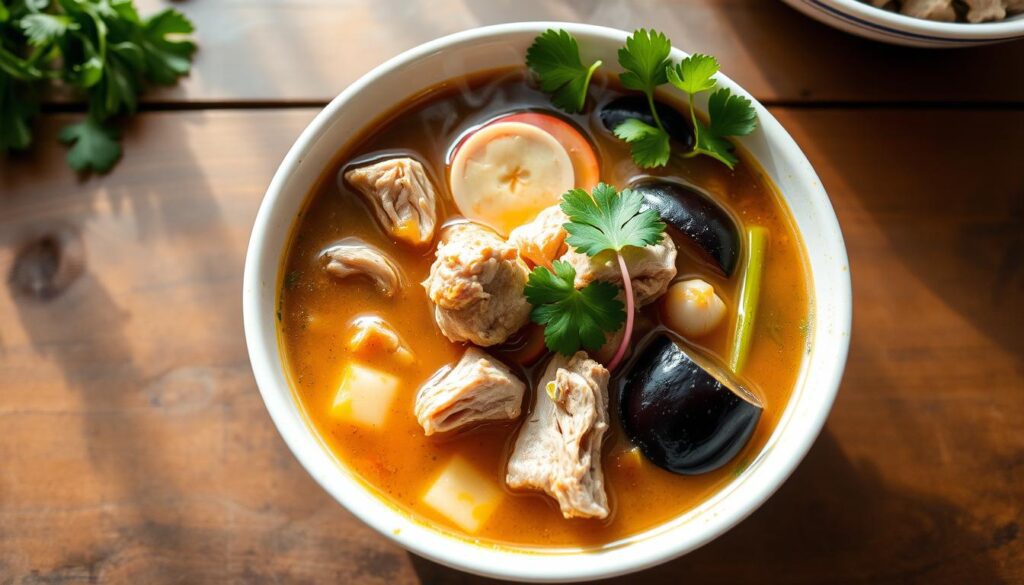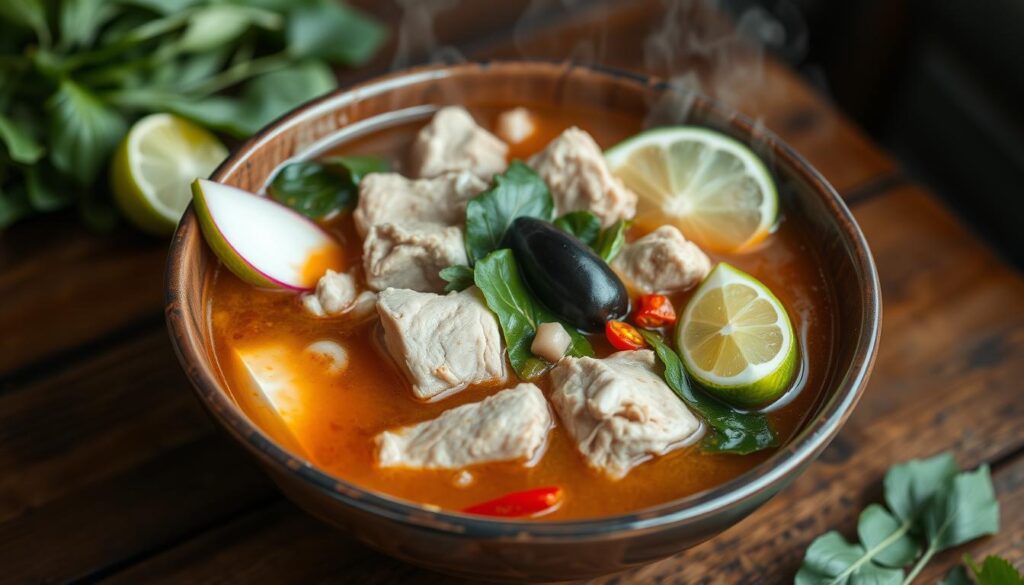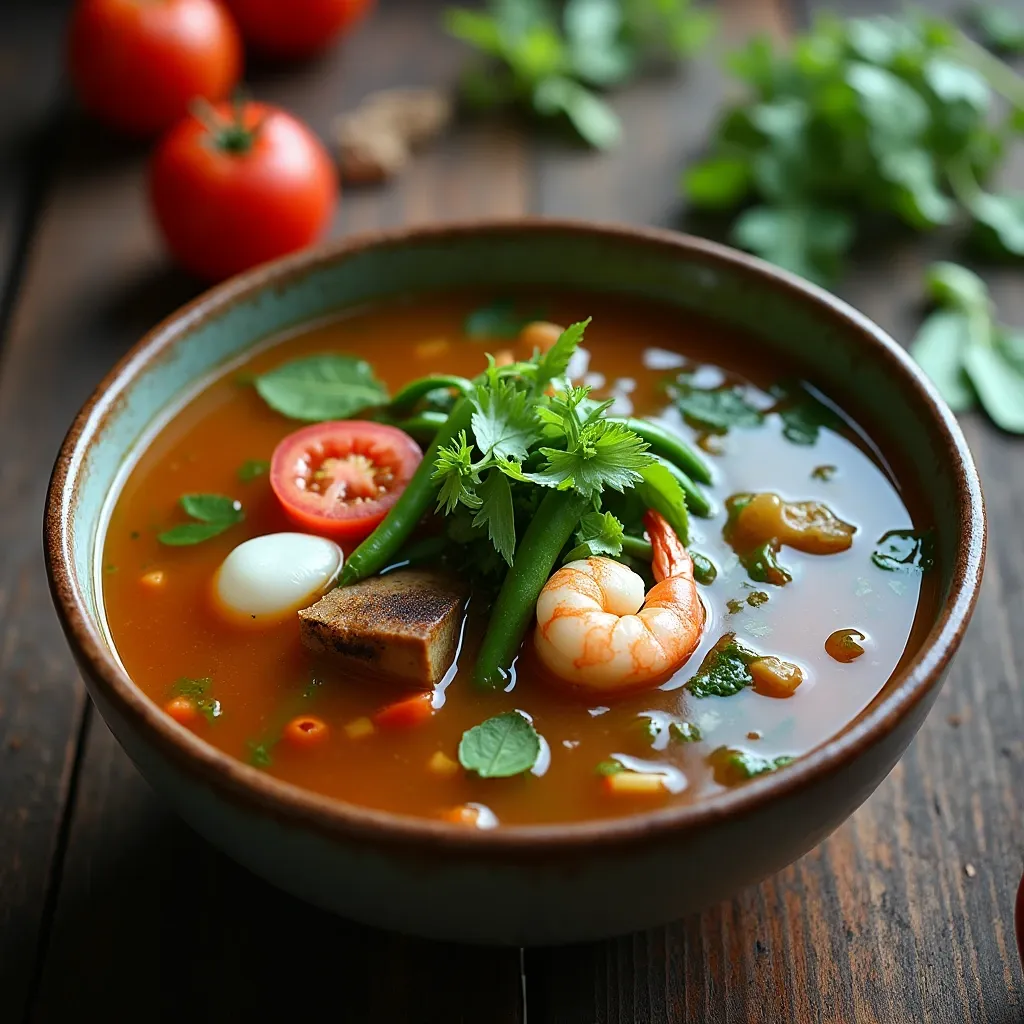Sinigang is a favorite Filipino soup known for its sour taste. It uses fresh, healthy ingredients. Traditionally, it’s made with pork, but you can also use seafood or tofu for a vegetarian option.
This soup is quick to make, ready in just 30 minutes. It’s perfect for those who want a healthy meal fast.

Key Takeaways
- Sinigang is a traditional Filipino soup known for its sour taste and healthy ingredients.
- The soup can be made with a variety of protein sources, including seafood and vegetarian options.
- Sinigang can be prepared quickly, making it a convenient and nutritious meal choice.
- The key ingredient in Sinigang, tamarind, provides the soup with a signature tangy and tart flavor profile.
- Proper seasoning and preparation techniques are essential for achieving the ideal balance of flavors in Sinigang.
Understanding Sinigang: A Traditional Filipino Soup
Sinigang is a favorite in Filipino food. It’s a tangy, savory soup loved across the Philippines. Its history goes back to before the Spanish came, mixing old and new flavors.
Origins and Cultural Significance
Sinigang started in the Philippines before the Spanish arrived. Tamarind, a sour ingredient, was key. It mixed with meats and veggies to make this famous soup. Over time, Sinigang changed, with each area adding its own twist.
Basic Ingredients Overview
- Tamarind: The essential souring agent that gives Sinigang its signature flavor profile.
- Protein: Typically pork or seafood, such as fish or shrimp, which provide the dish with its heartiness.
- Vegetables: A selection of fresh, seasonal produce, including tomatoes, onions, and leafy greens, add depth and nutrition to the soup.
Traditional Preparation Metho
Making Sinigang is a detailed process. First, the meat or seafood is cooked briefly. Then, tamarind and other ingredients are added, simmered until perfect. This careful method brings out the sour, savory, and umami flavors.

Sinigang is more than just food; it shows the Philippines’ rich food history. It shows how the country’s diverse influences and creativity have made dishes loved worldwide.
Nutritional Profile of Sinigang Ingredients
Sinigang is a favorite Filipino soup. It’s packed with nutrients thanks to its many ingredients. Tamarind is at the core, giving it a sour taste and a lot of health benefits.
Tamarind is full of vitamins and minerals like B and C, potassium, magnesium, iron, and more. It also has fiber for better digestion. Plus, it has antioxidants that help our bodies.
Vegetables in Sinigang add to its nutritional value. Spinach, long beans, and radish are just a few. They bring vitamins, minerals, and fiber for health. For example, spinach fights inflammation with vitamin C. Radish helps the liver and stomach with potassium and vitamin C.
The protein in Sinigang, like seafood or meat, makes it a filling meal. Seafood, like catfish, is good for the heart with omega-3s. Chicken or pork add amino acids for muscles.
| Nutrient | Amount per Serving | % of Daily Value |
|---|---|---|
| Protein | 20-25g | 40-50% |
| Total Fat | 5-10g | 8-15% |
| Saturated Fat | 2-4g | 10-20% |
| Cholesterol | 50-80mg | 17-27% |
| Carbohydrates | 10-15g | 3-5% |
| Dietary Fiber | 2-4g | 7-14% |
| Sugars | 3-5g | 6-10% |
| Vitamin A | 20-25% | 20-25% |
| Vitamin C | 35-50% | 35-50% |
| Iron | 10-15% | 10-15% |
| Potassium | 10-20% | 10-20% |
Sinigang’s ingredients make it a nutritious and balanced meal. It combines tamarind nutrition, vegetable nutrients, and protein sources for a healthy meal.
Health Benefits of Tamarind in Sinigang
Tamarind is a key ingredient in Sinigang, a traditional Filipino dish. It’s full of nutrients and compounds that are good for us. This tangy fruit can make our health better.
Antioxidant Properties
Tamarind is full of antioxidants, like beta-carotene. These help our eyes and fight damage from free radicals. Antioxidants are key in fighting off harmful substances and reducing inflammation.
Digestive Health Benefits
Tamarind has a lot of fiber, with 34 grams in half a cup. But it doesn’t raise blood sugar levels much. This makes it great for digestion and keeping energy stable.
Anti-inflammatory Effects
Tamarind pulp is rich in potassium and polyphenols, like flavonoids. These help lower body inflammation. Eating tamarind-based dishes like Sinigang can help those with chronic inflammation or arthritis.
Adding tamarind to your Sinigang soup is a tasty way to boost your health. It supports your overall well-being.

Is Sinigang Soup Good For You?
Sinigang is a traditional Filipino soup that’s good for you. It has vegetables, lean protein, and tamarind. These make it a balanced dish full of vitamins, minerals, and antioxidants.
The healthy soup has many vegetables like eggplant and tomatoes. These are full of nutrients and fiber. You can also add lean proteins like pork or seafood to make it your own.
Tamarind is a key ingredient in Sinigang. It adds a sour taste and has health benefits. Tamarind helps protect the body and reduce inflammation.
- Sinigang is gluten-free, Paleo, and Specific Carb Diet friendly, making it a versatile option for those with dietary restrictions.
- The soup can be personalized by substituting ingredients like shrimp for pork and omitting certain items for Specific Carb Diet compliance.
- Sinigang offers a variety of textures, from chewy rice to fall-off-the-bone pork and flavorful broth-soaked eggplant.
But, watch the sodium in Sinigang, as it can be high. You can adjust the recipe to use less fish sauce or low-sodium options. This way, the Filipino diet can fit your health needs.
Overall, Sinigang is a tasty and healthy soup. It’s full of nutrients and can be made to fit your diet. It’s a great choice for a nutritious meal.
Protein Sources in Sinigang: From Seafood to Meat
Sinigang, the beloved Filipino soup, offers many protein options. Seafood like milkfish (Bangus) are full of omega-3 fatty acids. These fats are good for your heart. They make the soup lean and tasty.
For lean meat, sinigang can have pork, beef, or chicken. These meats have lots of amino acids. They help fix muscles and give energy. Choosing lean cuts makes sinigang healthy and tasty.
Omega-3 Rich Options
Adding milkfish (Bangus) to sinigang boosts omega-3 fatty acids. These fats fight inflammation and lower heart disease risk. With 450 grams of bangus belly, you get lots of these nutrients.
Lean Protein Alternatives
Sinigang can also have pork, beef, or chicken for lean protein. These meats have amino acids for muscle repair and energy. Choosing lean cuts makes sinigang healthy and flavorful.
| Ingredient | Quantity | Nutritional Benefits |
|---|---|---|
| Milkfish (Bangus) Belly | 450 grams | Rich in omega-3 fatty acids, supporting heart health |
| Lean Pork/Beef/Chicken | Varies | Provides high-quality protein for muscle repair and energy |
| Kangkong (Water Spinach) | 100 grams | Excellent source of vitamins and minerals, including vitamin A, vitamin C, and iron |
| Sitaw (Long Beans) | 100 grams | Rich in dietary fiber, supporting digestive health |
| Daikon Radish | 100 grams | Provides antioxidants and aids in detoxification |
By mixing different proteins, sinigang meets many dietary needs. It supports a healthy lifestyle with fish protein and lean meat.
Vegetable Power: Essential Nutrients in Sinigang
Sinigang is more than just a tasty Filipino soup. It’s also a nutritional powerhouse. It has many vegetables, each adding important vitamins, minerals, and fiber.
Spinach is a key ingredient, packed with vitamins A, C, and K, folate, and iron. Tomatoes add vitamin C and lycopene, a strong antioxidant. Long beans, found in many Sinigang recipes, are full of fiber, vitamins A and C, and manganese.
| Vegetable | Key Nutrients |
|---|---|
| Spinach | Vitamins A, C, K, Folate, Iron |
| Tomatoes | Vitamin C, Lycopene |
| Long Beans | Fiber, Vitamins A, C, Manganese |
The way Sinigang is cooked, simmering the ingredients, keeps the vegetable nutrition and fiber intact. This makes Sinigang a nutritious and healthy meal to enjoy without guilt.
“Sinigang is a nutritional powerhouse, packed with essential vitamins, minerals, and fiber from its diverse vegetable ingredients.”
Sinigang Recipe for Health-Conscious Eaters
Sinigang, the beloved Filipino sour soup, can be easily adapted for health-conscious eaters. By making a few simple adjustments, you can enjoy the flavorful broth and nutrient-dense ingredients. This way, you can meet specific dietary needs. Let’s explore the possibilities of low-sodium and vegetarian variations of this traditional dish.
Low-Sodium Adaptations
To reduce the sodium in your sinigang, try a few key substitutions. Use a low-sodium fish sauce or a mix of calamansi (or lime) juice and soy sauce. This will give you the sour and savory taste without too much sodium. Also, watch the salt when seasoning the broth. You might want to use less or even skip it, letting the natural flavors of the ingredients shine.
Vegetarian Variations
For those on a vegetarian or plant-based diet, sinigang can be enjoyed with a few creative swaps. Use firm tofu or mushrooms as the protein source. They keep the dish hearty. You can also add vegetables like eggplant, okra, and daikon radish. They provide essential nutrients and fiber, keeping the sour and umami flavors of the soup.
By embracing these adaptations, you can enjoy a healthy and delicious sinigang. It caters to your dietary preferences without losing the authentic taste and nutritional benefits of this beloved Filipino dish.
“Sinigang is a true embodiment of the Filipino culinary spirit – balancing flavors, honoring tradition, and nourishing the body and soul.”
Best Practices for Preparing Healthy Sinigang
To make sinigang healthier, use fresh, top-quality ingredients. Choose lean meats or seafood like salmon or shrimp. Parboiling the protein before adding it to the soup removes extra fat and impurities.
Don’t overuse salt to flavor sinigang. Use tamarind’s natural sourness and fish sauce’s umami instead. Adding veggies like string beans, bok choy, and tomatoes boosts flavor and nutrition.
Good preparation and cooking are key to sinigang’s health benefits. Skim off fat and scum that forms during simmering. Using low-sodium broth or water also cuts down sodium, making it better for your heart.
FAQ
What is Sinigang, and what are its health benefits?
Sinigang is a sour Filipino soup made with fresh ingredients. It can be made with pork or seafood. It’s full of nutrients like vitamins and minerals from veggies and protein from meat or seafood.
What are the origins and cultural significance of Sinigang?
Sinigang started in pre-colonial Philippines with tamarind. It has grown with new influences, becoming a key dish in Filipino food. It’s very important in Filipino culture.
What are the key ingredients in Sinigang?
Sinigang’s main ingredients are tamarind, meat or seafood, and veggies like spinach and tomatoes. These give it a special taste and lots of nutrients.
How is Sinigang traditionally prepared?
To make Sinigang, meat is first parboiled. Then, tamarind and veggies are added and simmered. This way, the soup keeps its nutrients.
What are the health benefits of tamarind, a key ingredient in Sinigang?
Tamarind in Sinigang is good for you. It fights off germs, helps the heart, and might lower cholesterol and support the liver. It also has antioxidants and anti-inflammatory effects.
Is Sinigang considered a healthy soup?
Yes, Sinigang is a healthy soup. It has veggies, lean protein, and tamarind. It’s full of vitamins, minerals, and antioxidants. But, watch the sodium for those on special diets.
What protein sources can be used in Sinigang?
You can use seafood like milkfish or lean meats in Sinigang. Milkfish has omega-3s for the heart. Lean meats add protein without too much fat. You can pick what fits your diet best.
What are the health benefits of the vegetables in Sinigang?
The veggies in Sinigang, like spinach and tomatoes, are packed with nutrients. They add vitamins, minerals, and fiber. Cooking them right keeps these nutrients in the soup.
How can Sinigang be adapted for health-conscious eaters?
For health-conscious eaters, Sinigang can be made with less salt or without meat. You can use tofu or mushrooms for a meat-free version. This keeps the flavor while meeting dietary needs.
What are the best practices for preparing healthy Sinigang?
For a healthier Sinigang, use fresh ingredients and lean proteins. Cook it right to keep nutrients in. Use less salt and add lots of veggies for more nutrition.

